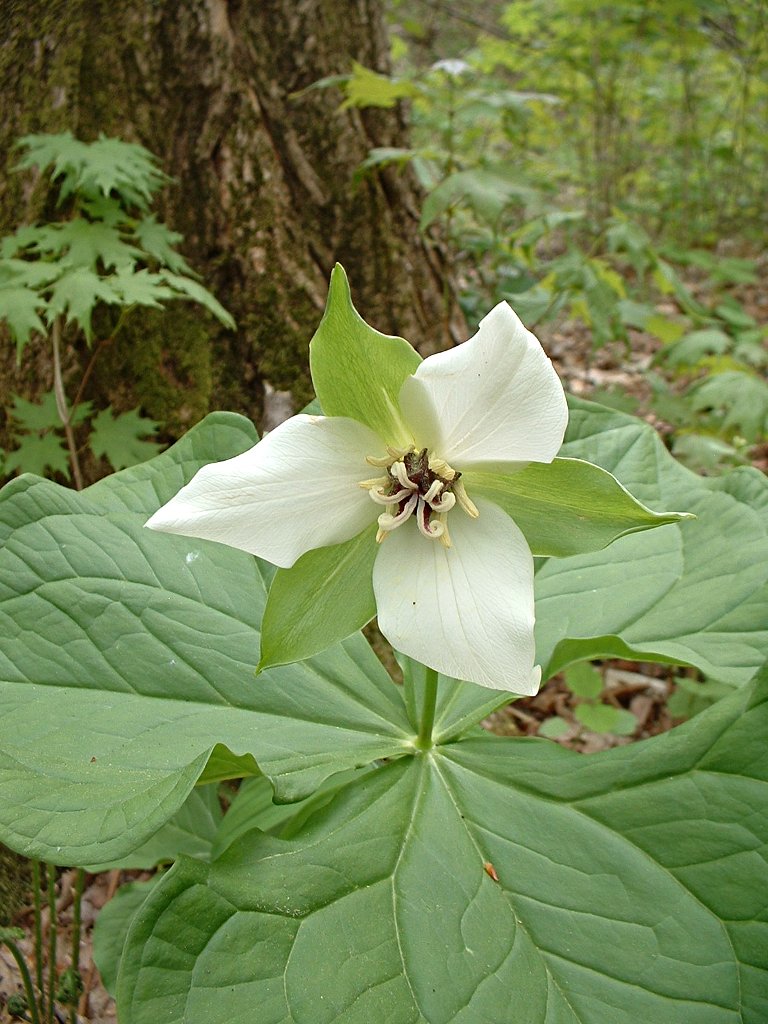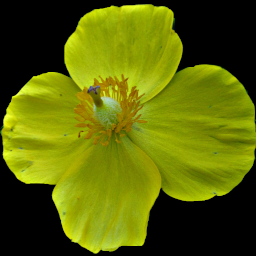
UPDATE: A kind commenter (see this article) identifies this plant as Trillium erectum, and further investigation convinces us that he was correct. We had previously identified it as Trillium cernuum, and we keep Gray’s description of that species in brackets below. We always receive these corrections and suggestions with profound gratitude.
Unlike the Great White Trillium, this species is a bit bashful. You have to stoop down to appreciate its nodding flowers. The most common color is a deep mahogany red, but in this patch of woods nearly every flower (of countless thousands) was white. This one was blooming at the beginning of May along the Trillium Trail in Fox Chapel. Another white form is here, and an unusual greenish-yellow form is here.
Gray describes the genus and the species:
TRILLIUM L. WAKE ROBIN. BIRTHROOT
Sepals 3, lanceolate, spreading, herbaceous, persistent. Petals 3, larger, withering in age. Stamens 6; anthers linear, on short filaments, adnate. Styles awl-shaped or slender, spreading or recurved above, persistent, stigmatic down the inner side. Seeds ovate, horizontal, several in each cell. Low perennial herbs, with a stout and simple stem rising from a short and praemorse tuber-like rootstock, bearing at the summit a whorl of 3 ample, commonly broadly ovate, more or less ribbed but netted-veined leaves, and a terminal large flower; in spring. (Name from tres, three; all the parts being in threes.) Monstrosities are not rare with the calyx and sometimes petals changed to leaves, or the parts of the flower increased in number.
Ovary and fruit 6-angled and more or less winged.
Flower pediceled; connective narrow, not produced; leaves subsessile.
Anthers at anthesis exceeding the stigmas.
T. eréctum L. Leaves very broadly rhombic, shortly acuminate ; peduncle (2—8 cm. long) usually more or less inclined or declínate; petals ovate to lanceolate (18-36 mm. long), brown-purple or often white or greenish or pinkish; stamens exceeding the stout distinct spreading or recurved stigmas; ovary purple; fruit ovoid, 2.5 cm. long, reddish. — Rich woods, e. Que. to Ont., southw. to Pa. and in the mts, to N. C. — Flowers ill-scented.
[Trillium cernuum L. Leaves very broadly rhombic-ovate; peduncles (833 mm. long) usually recurved; petals white or pink, ovate- to oblong-lanceolate (12-24 mm. long), wavy, recurved-spreading; filaments nearly or quite equaling the anthers; ovary white or pinkish ; stigmas stoutish, tapering from the base to the apex; fruit ovoid. Moist woods, Nfd. to Man., southw. to Pa., Mich., Minn., and in the mts. to Ga.]

8 responses to “Wake-Robin, White Form (Trillium erectum var. album)”
[…] Pingback: Wake-Robin, White Form (Trillium erectum var. album) « Flora Pittsburghensis […]
[…] Most of the others of the same species in the Squaw Run valley are white (see pictures here and here); the same species may also bloom in greenish-yellow. The odor is described in the Flora of […]
[…] of this flower is deep mahogany red, but in the Squaw Run valley the flowers are almost always white. Occasionally a pink one shows up, as this one did, which was blooming at the beginning of […]
[…] is most commonly mahogany red in most of its range, but in our area the white form (more pictures here and here) is most common. There is also a pink form and a greenish-yellow […]
[…] is most commonly mahogany red in most of its range, but in our area the white form (more pictures here and here) is most common. There is also a greenish-yellow form., and this very rare pink […]
[…] is most commonly mahogany red in most of its range, but in our area the white form (more pictures here and here) is most common. There is also a greenish-yellow form., and this very rare pink […]
[…] all the others of the same species in the Squaw Run valley are white (see pictures here and here); in fact, among countless thousands we found only two clumps of red like this, one […]
[…] are most commonly red, but in Fox Chapel they are almost exclusively white (see pictures here and here); among countless thousands, this was the only yellow clump we found. The odor is described in the […]